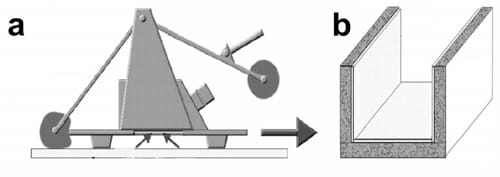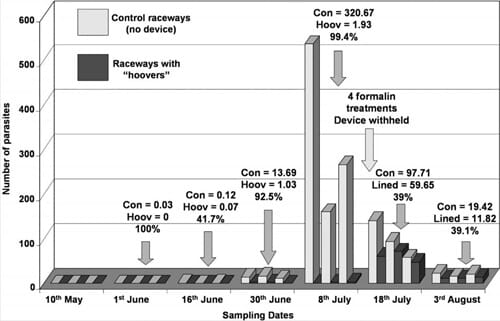A joint research program funded by the British Trout Association, DEFRA and SARF between the Parasitology Group at the Institute of Aquaculture and Pisces Engineering Ltd., has led to the development of a patented mechanical system which helps to remove the threat of white spot - Ichthyophthirius multifiliis - one of the major causes of disease mortality in global freshwater aquaculture (Figure 1).
Because of the rapid proliferation of this disease in aquaculture systems and the recent ban of the principal drugs employed for its control in food species (malachite green and dimetridazole), the industry currently lacks effective options for management and control of this key pathogen.
 |
| Figure 1. A heavy infection of Ichthyophthirius multifiliis on native brown trout, Salmo trutta. |
To find an environmentally safe, non-chemical alternative to controlling infections, a mechanical device, “SystemIch”, was constructed and tested for its ability to remove parasite cysts from commercial trout raceways (Figure 2).
The primary mechanical device consisted of a special suction head connected to a pump that was used to vacuum the bottom of hatchery raceways. The design of the vacuum ensured that even very small fry were not drawn in or damaged by it, whilst retaining sufficient suction and mechanical action to remove the cysts and other debris.
A secondary and equally necessary device was the use of a low-adhesion polymer sheeting that was used to line concrete raceways. Following the testing of a series of polymers, the most efficacious product in preventing cyst attachment was used to line three raceways (6m × 1m × 1m) in a commercial trout hatchery in Scotland.

Figure 2. (a) A special suction head was connected to a pump that was used to vacuum the bottom of the hatchery raceways; (b) a low-adhesion polymer sheeting was used to line concrete raceways.
Over a period of three months, each lined raceway was vacuumed once per day; while the three control raceways were brushed as normal. Every two weeks, twenty fish from each raceway were sampled and the total number of trophonts on each fish was determined. Statistical analysis of the collected trophont data confirmed the efficacy of the mechanical device in reducing establishing trophonts numbers by >99.4% (p<0.0001) (Figure 3).
To ascertain the benefits of only using the polymer sheeting lining raceways in reducing infections, the use of the suction head was withheld and infection levels on fish in raceways were followed for Figure 3.
The number of I. multifiliis trophonts per fish in the control and device raceways at the different sampling dates throughout the experimental period. Parasite numbers on the control fish on the 8th July were so high that formalin treatments had to be administered to control the number of infectious stages in the water column and to ensure the health and welfare of fish. another month.
Trophont numbers on the fish in the lined raceways were observed to slowly increase but remained ~39% lower than levels on the control fish (Figure 3).
An additional benefit is that the SystemIch device is also very effective at removing uneaten feed and faeces, resulting in improved water quality and the team expects the system to also have far reaching benefits for other pathogenic and environmental problems in aquaculture.

Figure 3. The number of I. multifiliis trophonts per fish in the control and device raceways at the different sampling dates throughout the experimental period. Parasite numbers on the control fish on the 8th July were so high that formalin treatments had to be administered to control the number of infectious stages in the water column and to ensure the health and welfare of fish.
March 2008

